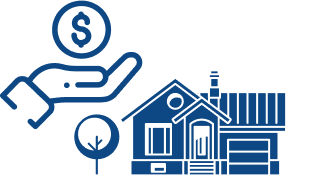You probably don’t think about amortization every day, but how you manage your mortgage can significantly affect everything from your day-to-day finances to your life in 10, 20, or 30 years.
If you spend wisely, you have greater chances of financial security and freedom. On the other hand, irresponsibility could lead to you losing your home. That said, avoiding the troubles demands understanding different loans and their advantages and disadvantages. So, what is a negative amortization loan, and how can it affect your finances? Keep reading to discover the answer to this question so you can make a wise choice.
Understanding Amortization
Amortization is the process of paying off a loan in equal payments over time, where part of each payment goes toward the loan’s principal, and the other part goes toward interest. Paying interest is typically prioritized in mortgage loans, meaning you’ll pay more toward interest than principal at the start of the loan. And as you pay down the loan, you’ll put more toward the principal.
Throughout the loan, the amount you pay toward the loan principal will gradually overtake the amount you pay toward interest. This means that toward the end of paying off the loan, you’ll pay very little interest and mostly principal.
The most common loans that use amortization are mortgages and car loans. So, with a 30-year mortgage, you will spend the first several years paying down the interest. In the remaining years, you will focus on paying down the loan principal. This is part of the reason why paying off a mortgage quickly can save you significant amounts of money in interest payments
How Negative Amortization Works
When you pay less than the interest charges in any month, there’s unpaid interest. As a result, the unpaid amount is added to your loan balance. And if you don’t pay enough to cover interest costs, your payments aren’t sufficient to pay down your loan balance. This results in bigger debt on the loan each month. While you don’t receive any money from the lender, your loan balance increases as you’re adding interest charges every month.
The primary reason to pay less is that it’s easier on your cash flow. However, eventually, you will have to pay off the loan. And you can do this in several ways:
- Through regular amortizing payments, which will be higher than they would have been with the original loan arrangements since your loan balance grows if you don’t pay interest.
- By refinancing
- By making a balloon payment
Unable to Pay
Sometimes, a person may not have enough money to make large monthly payments. For instance, if you’re unemployed, you may not be able to pay off your student loans. With federal student loans, you may be able to apply for deferment. This will allow you to stop making payments temporarily.
However, the interest will still apply to the loan balance, and you’ll be responsible for it unless you have subsidized loans. If you want to avoid negative amortization, often, you’ll have the option to pay the interest while skipping the larger payment.
Investors
Sometimes, investors want to avoid large monthly payments, especially for short-term projects such as fix-and-slip. Although this is a risky way to invest, some investors manage to do it successfully. However, for this strategy to pay off, you’ll need to sell the property with enough profit to pay off the interest.
“Stretching” to Purchase
Some buyers will use negative amortization to buy a property that’s out of their price range. The presumption is that they will have more income in the future, and they would rather buy a more expensive property now than buy a cheaper one and move again later. However, this is a risky strategy because you can’t predict the future.
Loans that Feature Negative Amortization
Some of the most common loans that feature negative amortization are the following two types of mortgages:
Adjustable-Rate Mortgages
These loans are where the interest varies throughout the loan. With this type of loan, you can choose to make a payment lower than the fully amortized payment. The interest rate is usually locked in for an initial period of three, five, or seven years. After that, it adjusts periodically - typically every six to 12 months. Note that the initial rate is usually lower than the current average interest rate for a fixed-rate loan.
With the adjustable-rate mortgage, the borrower can decide how much of the interest portion they wish to pay each month. And any unpaid interest is added to the loan balance.
Graduated Payment Mortgages
This loan is a type of fixed-rate mortgage where the payments grow gradually over time from an initially low base rate to a higher final interest rate. The payments usually increase between 7% and 12% yearly until they reach the full monthly payment amount.
Note that not every state allows negative amortization mortgage options. That’s especially true since the subprime mortgage meltdown of 2008.
When Might a Negative Amortization Be Beneficial?
While increasing or unpredictable interest rates and mortgage payments may sound unattractive at first, they can be an excellent financial choice in some cases.
For example, if you have short-term expenses to cover and, as a result, don’t have enough money during the next several years, you could benefit from negative amortization. In this case, your principal payments will be lower initially, buying you time to cover other expenses. However, you should have a plan to refinance the loan before the high principal balance comes due.
A negative amortization loan isn’t used to pay off the house. Rather, it’s used to use equity to allow you to stay in the property at a lower monthly payment for a short time.
Another situation where a negative amortization can benefit you is if you’re an investor who’s flipping a home, and you know you won’t stay in the property for an extended period of time. Instead of tying your cash reserves to an asset you won’t be paying off fully, you can keep the liquidity to invest in advancements or other investments, which can result in higher sales prices.
Finally, a negative amortization can make sense if you earn a lot of money but not in a steady manner. In this case, a negative amortization loan can be used as a method of cash flow management rather than a support of affordability which can result in a house you can’t afford.
That said, if you’re a high-net-worth borrower with sufficient income and assets and a large down payment, you can benefit from a negative amortization loan. If you see the bulk of your income at one time of year or irregular intervals, you can use the loan to preserve cash flow in the months without earning. Then, you can make a significant payment against the principal in the months when your income is rolling in.
The Drawbacks of Negative Amortization
The main reason many people avoid negative amortization loans is that they will pay more on the property overall. The option to postpone paying down the mortgage could lead to a situation where you’re underwater on the loan.
This can happen because of unexpected circumstances affecting your cash flow and overall liquidity. Also, it can occur if the average interest rate outpaces your cost of living. And this can lead to the threat of foreclosure on a property.
Some people are too optimistic about their future earning potential, so they buy more than they can afford in the future. That’s why you should pay off all the interest on your loans as soon as you can to avoid paying interest on interest.
In a market where home prices are skyrocketing, buyers should avoid using negative amortization loans because a reduction in house prices can offset even a healthy down payment.
Sell Your Home Without Hassle
Although negative amortization loans can benefit some people (especially investors who are flipping a home), they can also have extremely adverse effects on your wallet in the long run.
If you want to avoid the risks associated with negative amortization, why not sell your home to us? SleeveUp Homes will buy your home as-is for top dollar, even if it’s threatened by foreclosure. If you like what you hear, request a no-obligation cash offer and see how much you can profit.
SELL
YOUR HOUSE
If you want to sell fast and are worried about how long the traditional process takes, and the commission and fees involved, consider working with SleeveUp Homes.





 view all blogs by this author
view all blogs by this author Zachariah Peterson (69 blogs)
Zachariah Peterson (69 blogs)